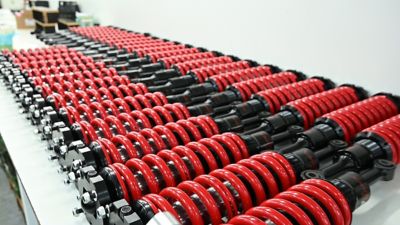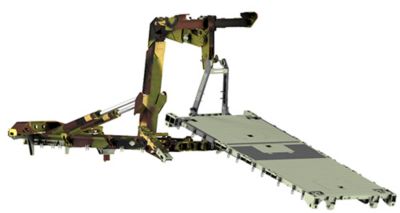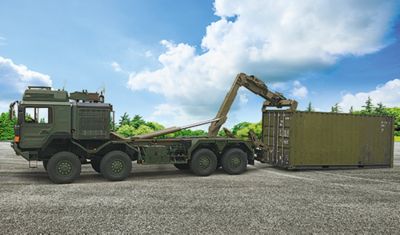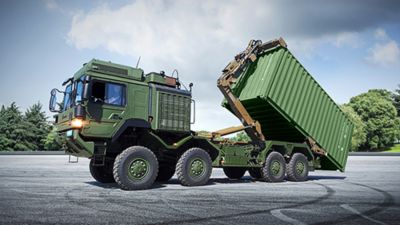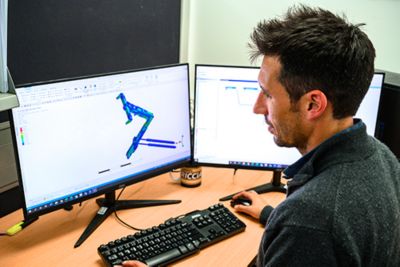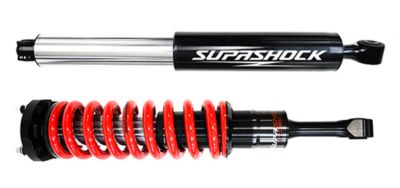ANSYS ADVANTAGE MAGAZINE
January 2021
Supashock Smoothly Expands Business with Simulation
By James Browne, Senior Structural Design Engineer, Supashock, Adelaide, Australia
Supashock began in 2005 by focusing on how shock absorbers could be improved for the racing industry and has since expanded into developing suspension and mobility systems for many other applications.
From his years of experience as a race car engineer, Supashock founder Oscar Fiorinotto knew that tires and shock absorbers were considered “black arts” rather than well-understood components of race cars. Even cutting-edge shocks left a lot to be desired in damping out the bumps and swerves that a race car experiences on a track. Driven by his passion for understanding and controlling motion, Fiorinotto started disassembling shocks and analyzing their operation at a time when there was very little engineering literature about how they worked. Eventually he discovered the critical elements of shock absorbers and founded Supashock in 2005.
But, as with most startups, the going wasn’t easy. After being turned down by all the major automotive original equipment manufacturers (OEMs) in Europe when he tried to sell his new shock absorber design to them, Fiorinotto was heading back to his native Australia disappointed. As a last resort, he asked a race car–owning friend if he would take a chance on his shock absorbers for an upcoming world-class championship race. The friend agreed. On race day, the car completed the first laps a half-second faster than it ever had before — a major improvement in auto racing circles. The car, which normally finished in the back of the pack, finished second that day. A representative from one of the OEMs in attendance, who had recently rejected Fiorinotto’s sales pitch, approached him after the race about setting up another meeting. But Fiorinotto had already made a commitment to the new team.
Over the years, Supashock has been successful in designing and manufacturing suspension and mobility systems for consumer cars, race cars, mining vehicles and armored military vehicles, among others. In 2016, Fiorinotto first began working with LEAP Australia, Ansys Elite Channel Partner for Australia and New Zealand, to apply Ansys Mechanical software to Supashock’s shock absorber designs. By conducting virtual tests of new shock absorber designs, it was immediately clear to Fiorinotto that in addition to saving both time and money, simulation also provided his team with the right tool to accelerate the pace of innovation that was occurring within his engineering team.
The Challenge of Shock Absorbers
Shock absorbers are critical components for vehicle dynamics. They enable pinpoint handling in tight curves on a racecourse and are the difference between the bumpy ride you might be getting from a low-end consumer car compared to the precise handling yet still comfortable ride of a luxury car.
Suspension systems contain both springs and dampers (commonly referred to as shock absorbers or just “shocks”). A damper consists of an internal rod that slides in and out of an external cylinder, forcing a viscous fluid through orifices to control the speed of the suspension motion. The spring, which may be a traditional coil or even a gas spring, is often included in the same structure. The spring and damper must be tuned together in order to produce the optimum compromise between ride comfort and handling performance.
These dynamic structures experience many different loads during operation, and they must perform well and maintain structural integrity through their life (remembering that in some vehicles, this structure is literally holding the wheels on the car!). This means that, depending on the type, the shock absorber needs to be analyzed in a variety of positions, ranging from fully extended (droop) to fully compressed (bump) with differing loading conditions.
The internal rod’s motion is constrained by a sliding contact, with linear bearings that allow the low friction, axial movement of the rod as the wheel moves up and down. As a result, the FEA models require nonlinear contacts. Fatigue must also be considered due to the long life and repeated loads experienced by vehicles.
Supashock has expanded into logistics and handling technologies. The company uses Ansys Mechanical’s topology optimization to reduce the pictured loading system weight and speed without reducing capacity.
Simulating a New Shock Absorber Design
Supashock’s eight design engineers start with a computer-aided design (CAD) model of a shock absorber and defeature the geometry in Ansys SpaceClaim, removing thread details and features that are not structurally relevant to simplify it for simulation.
The “share topology” function in SpaceClaim is used to combine joined components (such as at welds). After meshing the model, usually an initial linear solve is performed within Ansys Mechanical, representing bushings as joints and applying forces and pressures to make sure the model behavior is valid, prior to introducing additional complexity with nonlinear contacts.
As the shock absorber is often required to be analyzed in a variety of different positions through its stroke, either the “configure joints” or “body transformation” feature of Ansys Mechanical is used to move the rod relative to the cylinder, without having to re-import the altered geometry from SpaceClaim. This has proven to be a more efficient workflow than modifying the geometry itself.
The Automated Load Handling System
Over the years, Supashock has expanded well beyond racing. For example, the company now supplies products to the defense industry for military vehicles. Rheinmetall AG of Germany is one of their major customers in this field, and a key partner for Supashock in the development of mobility and logistics handling technologies.
In 2017, Rheinmetall presented Supashock engineers with a big challenge: Design a new automated load handling system (ALHS) that could rapidly and automatically load a shipping container or DIN/STANAG roller container (or flatrack) weighing up to 16.5 metric tons onto a Rheinmetall military truck without outside human intervention.
Existing load-handling systems required a person to leave the safety of an armored vehicle to connect the loading device to the shipping container, which is an obvious danger in military situations. Rheinmetall wanted a system that could be operated by one person inside the armored vehicle and, if possible, complete the loading process in record time. The loader also had to be as light as possible because every kilogram of mass in the loader was one less kilogram of payload that could be transported.
The solution to this challenge was to design a hook loader that lifted the container from the top with connections at only two points, as compared to the existing loader that had a frame that required a human to connect it to the container at its four edges. The first question that arose was whether a standard shipping container could withstand the forces involved in being lifted from only the top. A quick simulation in Mechanical showed that it could.
By far the biggest challenge was analyzing all of the load cases involved in a hydraulic lifting system undergoing a large range of motion with many degrees of freedom in order to complete the loading sequence while compensating for misalignment and payload variations.
In these scenarios, the “configure joints” feature was used to produce a time-efficient workflow. Traditionally, an engineer would have to reset the model for each of these load cases from the geometry, altering the CAD model in the preprocessor and re-importing it into Mechanical. Using the “configure joints” functionality, the translational joints in the hydraulic cylinders were used to move the structure to check different positions in the loading sequence.
As well as looking at individual loading positions, by using “large deflections” the full range of motion was assessed in one solve by providing the relative hydraulic cylinder displacements in different time steps though the loading sequence.
The output of this solve stores the stresses/displacements of the structure at all of the time steps through the loading sequence, allowing a “maximum stress over time” and “time of maximum stress” plot to show the magnitude and the position in the loading sequence that causes the greatest stress in the structure.
A graph of all the loads on the hydraulic cylinders throughout the full loading sequence was compared and cross-validated with spreadsheet calculations based on a free body diagram of the system, giving them confidence that they had correctly sized all the actuators.
Ansys Mechanical’s topology optimization feature has also helped Supashock to significantly reduce the overall weight of the loading system by identifying where mass could be taken out of the structure without compromising the required stiffness or producing stresses over allowable limits. This enabled significant weight savings, critical for maximizing the payload.
Physical strain gauge testing as well as measurements of hydraulic cylinder pressures from testing, after the load handling system had been constructed, confirmed the accuracy of the Mechanical simulations that were performed during the project design phase.
James Browne, Senior Structural Design Engineer, Supashock, uses Ansys solutions to help develop new products and optimize existing ones.
A History of Success
Rheinmetall had requirements and a vision for a loading system that was capable of lifting a container from the top without human intervention. Supashock took their requirements and successfully turned it into an operational system. The ALHS can now load a container in half the time it took with conventional loaders, with no human intervention — meaning that the operator can remain safely within the armored portion of the vehicle. With the help of Ansys Mechanical, Supashock engineers designed the ALHS to increase the capability and speed of loading without sacrificing payload capacity.
Let’s not forget the shock absorbers that were the beginning of Supashock’s success and that continue to be improved each year. In 2019, the Supercars Championship — Australia’s top-level racing championship — decided to standardize one homologated shock absorber for all competing teams. Supashock was chosen to be the sole supplier of shocks to the Supercars Championship starting in 2020 — a major victory for a company that got its start by exceeding all expectations on a global stage as an Australian SME against the giants of the industry. Supashock also supplies the control shock absorber for New Zealand’s Toyota Racing Series, the premier open wheel series in New Zealand.
Supashock’s use of Ansys is supported by Ansys Elite Channel Partner, LEAP Australia.
讓我們開始吧
如果您面臨工程挑戰,我們的團隊將隨時為您提供協助。憑藉豐富的經驗和對創新的承諾,我們邀請您與我們聯絡。讓我們共同合作,將您的工程障礙轉化為成長和成功的機會。立即與我們聯絡,開始對話。
